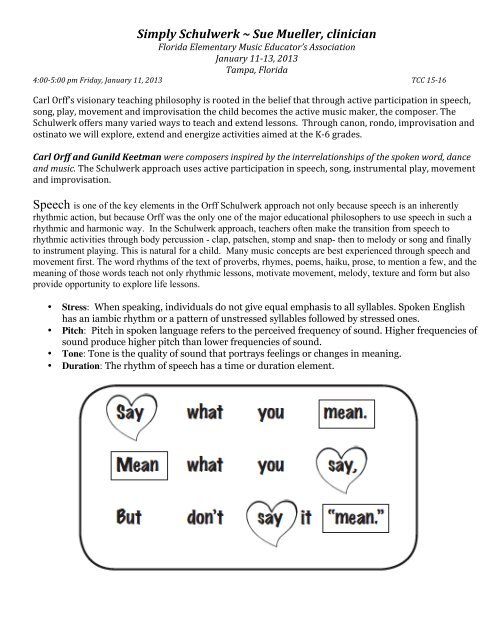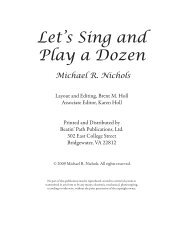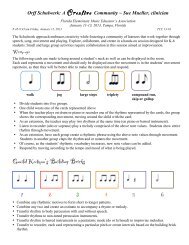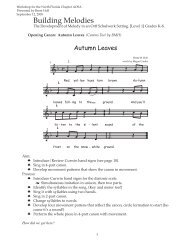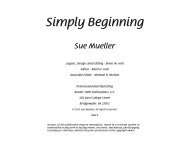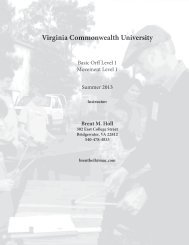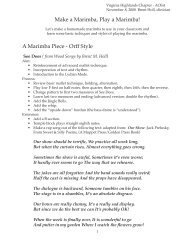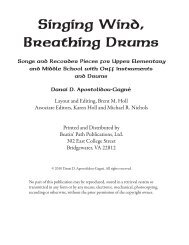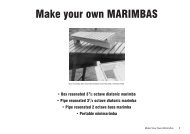FMEA Simply Schulwerk - Florida Music Educators Association and ...
FMEA Simply Schulwerk - Florida Music Educators Association and ...
FMEA Simply Schulwerk - Florida Music Educators Association and ...
You also want an ePaper? Increase the reach of your titles
YUMPU automatically turns print PDFs into web optimized ePapers that Google loves.
<strong>Simply</strong> <strong>Schulwerk</strong> ~ Sue Mueller, clinician <strong>Florida</strong> Elementary <strong>Music</strong> Educator’s <strong>Association</strong> January 11-‐13, 2013 Tampa, <strong>Florida</strong> 4:00-‐5:00 pm Friday, January 11, 2013 TCC 15-‐16 Carl Orff’s visionary teaching philosophy is rooted in the belief that through active participation in speech, song, play, movement <strong>and</strong> improvisation the child becomes the active music maker, the composer. The <strong>Schulwerk</strong> offers many varied ways to teach <strong>and</strong> extend lessons. Through canon, rondo, improvisation <strong>and</strong> ostinato we will explore, extend <strong>and</strong> energize activities aimed at the K-‐6 grades. Carl Orff <strong>and</strong> Gunild Keetman were composers inspired by the interrelationships of the spoken word, dance <strong>and</strong> music. The <strong>Schulwerk</strong> approach uses active participation in speech, song, instrumental play, movement <strong>and</strong> improvisation. Speech is one of the key elements in the Orff <strong>Schulwerk</strong> approach not only because speech is an inherentlyrhythmic action, but because Orff was the only one of the major educational philosophers to use speech in such arhythmic <strong>and</strong> harmonic way. In the <strong>Schulwerk</strong> approach, teachers often make the transition from speech torhythmic activities through body percussion - clap, patschen, stomp <strong>and</strong> snap- then to melody or song <strong>and</strong> finallyto instrument playing. This is natural for a child. Many music concepts are best experienced through speech <strong>and</strong>movement first. The word rhythms of the text of proverbs, rhymes, poems, haiku, prose, to mention a few, <strong>and</strong> themeaning of those words teach not only rhythmic lessons, motivate movement, melody, texture <strong>and</strong> form but alsoprovide opportunity to explore life lessons.• Stress: When speaking, individuals do not give equal emphasis to all syllables. Spoken Englishhas an iambic rhythm or a pattern of unstressed syllables followed by stressed ones.• Pitch: Pitch in spoken language refers to the perceived frequency of sound. Higher frequencies ofsound produce higher pitch than lower frequencies of sound.• Tone: Tone is the quality of sound that portrays feelings or changes in meaning.• Duration: The rhythm of speech has a time or duration element.
Say What You MeanAim: Experience 6/8 meter using speech. Grade Level: K-1Anticipatory set:• Discuss the meaning of the text. Talk about speaking in a courteous, sincere manner with friends,teachers, parents. Include in the discussion the reasons for speaking sincerely when expressing thanks,forgiveness, etc.Process:• Teach the text poem using the echo process until secure.• Speak the rhyme in different ways, exploring voice timbres that illustrate different emotions such as anger,delight, friendship, helpfulness, etc.• Speak the text twice clapping the word “say.”• Speak the text twice <strong>and</strong> patsch the word “mean.”• Speak the text twice clapping <strong>and</strong> patsching selected words.• Repeat above sequence, internalizing the words “say” <strong>and</strong> “mean.”• Replace text with body percussion internalized.Play an elimination game:• Speak the text, replacing the word “say” with claps.• Speak the text, replacing the words “say” <strong>and</strong> “mean” with claps <strong>and</strong> patsches.• Internalize the entire text, replacing the words “say” <strong>and</strong> “mean” with claps <strong>and</strong> patshces.o Hint: To keep students together “feeling” the pulse, the teacher may need to play an external pulseon a drum.o Create a word chain using “heart expressions.”• Arrange the four heart expressions in desired order at student’s suggestion.• Speak the four measure pattern of expressions in interesting voice timbres.Performance suggestions:Introduction:ABASpeak rhyme twice using expressive voice timbre.Speak rhyme twice with body percussion on selected words.Speak four measure pattern of words in hearts twice.Speak rhyme twice with body percussion on selected words.Extensions:• Transfer body percussion to non-tuned percussion.o Transfer body percussion to found sounds.o Transfer body percussion to an action or gesture.o Transfer body percussion to barred instruments playing any two notes of chosen pentatonic scale.o Students create new expressions to replace the four heart expressions.St<strong>and</strong>ards <strong>and</strong> objectives:National St<strong>and</strong>ards :• Performing on instruments, alone <strong>and</strong> with others, a varied repertoire of music.• Composing <strong>and</strong> arranging music within specified guidelines.Lesson objectives:• Experience 6/8 meter using speech <strong>and</strong> body percussionPlease?Thank you.I’m sorry.You’re welcome.
<strong>Music</strong> <strong>and</strong> movement are natural partners. Movement is an essential component of the <strong>Schulwerk</strong>.“Out of movement, music. Out of music, movement.” Dorothee GüntherMovement <strong>and</strong> rhythm are basic elements of nature: changing seasons, ebb <strong>and</strong> flow of tides, heartbeat, sleeppatterns, walking <strong>and</strong> running. Movement to rhythm <strong>and</strong> pulse plays an important facet in developing students’sense of coordination <strong>and</strong> body awareness. Physical response to music is an effective <strong>and</strong> fun way to teach thebasic elements of music. Movement is natural to the child, <strong>and</strong> can provide a means of expression, release ofenergy <strong>and</strong> develop community. Starting with reaction training, to moving in <strong>and</strong> through space in different waysusing a variety of meters, the child learns balance, rhythm, <strong>and</strong> develops a toolbox for creativity.Movement activities in the music classroom should be aligned with a child’ s development of motor skillsbeginning with simple behaviors, such as walking, <strong>and</strong> progress to more challenging <strong>and</strong> complex activities.Simple to complex guided movement experiences provide a natural basis for expression <strong>and</strong> underst<strong>and</strong>ing gearedto the child’s development <strong>and</strong> the elements being taught. Consider many types of movement exercises in yourteaching.~ Spatial <strong>and</strong> body awareness~ Movement that teaches musical concepts~ Creative <strong>and</strong> expressive movementImprovisation: The role of improvisation permeates all aspects of the <strong>Schulwerk</strong> process. The student whoimprovises <strong>and</strong> creates his/her own movement, melody, rhythm <strong>and</strong> accompaniment is better prepared to solveproblems in other areas of life <strong>and</strong> in a variety of contexts. Improvisation <strong>and</strong> the Orff <strong>Schulwerk</strong> process developthe child’s intellectual, social, emotional <strong>and</strong> aesthetic awareness.Jump rope rhyme: Don’t say ain’t.Uh, uh.Your mother will faint.Oh yeah.Your father will fall in a bucket of paint. Oh no, dad’s gonna ground me,wish I hadn’t said that word.Your sister will cry.She always cries.Your brother will die.Of embarrassment.The dog <strong>and</strong> the cat will say goodbye! Oh well, I guess it’s my fault,I’ll never say ain’t again!Process:• Students learn to speak the words in green.• Teacher speaks the words in black.• Put the word rhythms on body percussion, h<strong>and</strong> drums, tubanos, or non-tuned percussion.• Practice without words.• Now, students improvise their own rhythms in response to teacher playing the first part.
We Are OneUsing a familiar folk song or literature in the students’ repertoire, show pulse, measure <strong>and</strong> phrase through movement: §§§Sing a familiar song in the student’s repertoire. Divide students into four groups. One group creates a movement to show • Pulse • Length of a measure • Length of a phrase • Melodic rhythm • As a variation: Each group creates a way to show all of the above within their group. Share with class. Using the children’s book We Are One by Jennifer Black, we will take the song below <strong>and</strong> weave it into the story. We will determine the accompaniment according to the elements of music explored above. Many thanks to West <strong>Music</strong> Co. <strong>and</strong> Beatin’ Path Publications for their support of this session.


